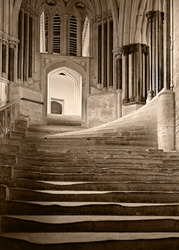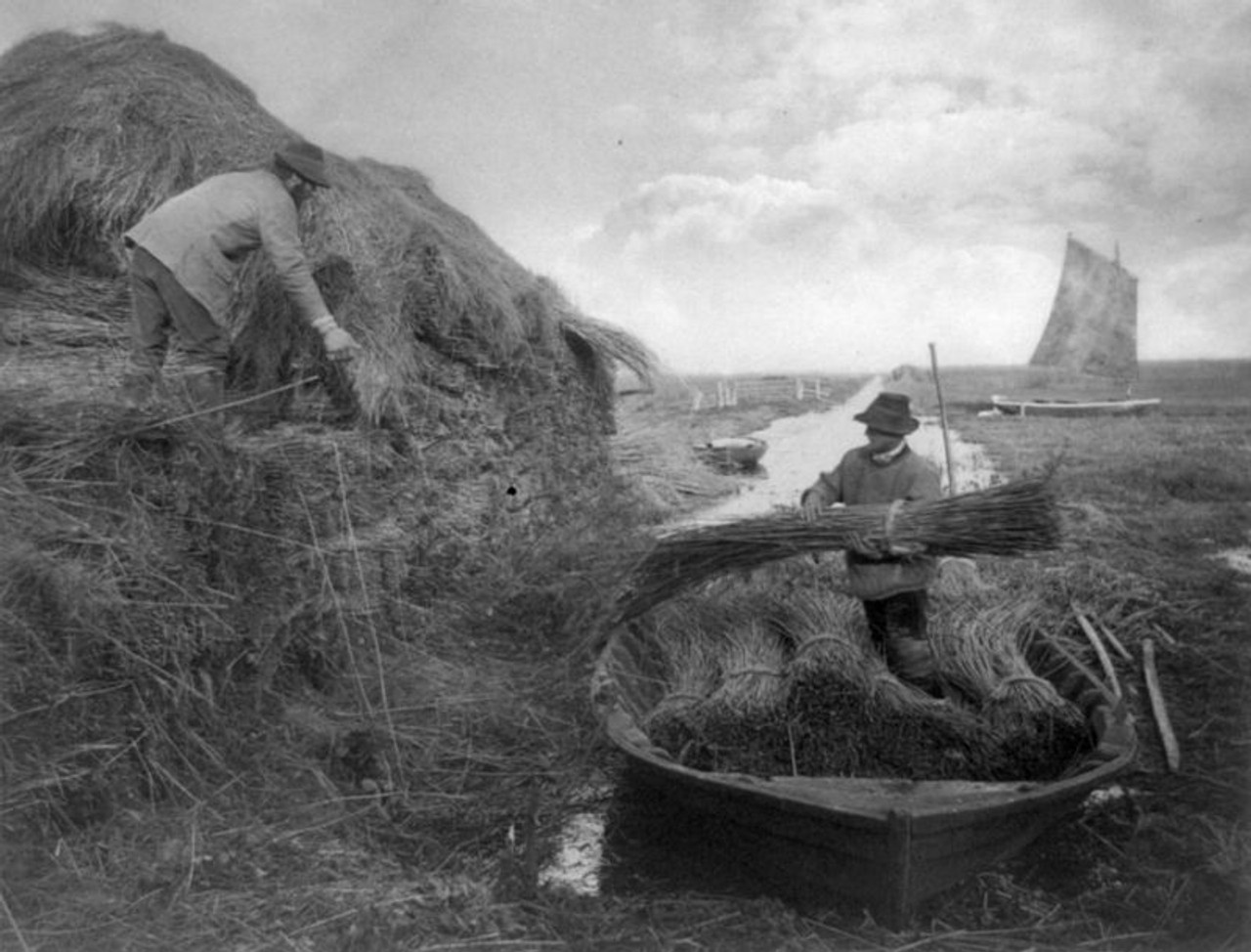Product Description
Platinum Printing Process, from Wall's Dictionary of Photography
 Platinum Process. A contact printing process based on the reduction of a ferric salt to a ferrous salt by the action of light. The ferrous salt is in turn made to reduce a platinum compound to metallic platinum, this forming the final image. Owing to the chemically inert nature of platinum, a print so made is far more permanent than any print having a silver image can be. No emulsion is used, so that the picture lies on the natural surface of the paper, allowing prints of distinctive character to be made.
Platinum Process. A contact printing process based on the reduction of a ferric salt to a ferrous salt by the action of light. The ferrous salt is in turn made to reduce a platinum compound to metallic platinum, this forming the final image. Owing to the chemically inert nature of platinum, a print so made is far more permanent than any print having a silver image can be. No emulsion is used, so that the picture lies on the natural surface of the paper, allowing prints of distinctive character to be made.
Owing largely to the high cost of platinum, the process is much less used than in the past, and commercially-prepared paper is no longer available in this country. Paper may, however, be sensitized by hand without much difficulty. The formula and instructions given here are largely due to Paul L. Anderson (American Photography, Oct, 1937, and July, 1938).
The paper used should be of high quality, and if extreme permanence is desired a linen paper should be used. Drawing paper of most types is suitable, and some varieties may with advantage be sized. For this, soak 150 grs. (11 gms.) of opaque gelatin in 30 ozs. (1,000 c.c.) of water for half an hour and dissolve on a water-bath at 140° F. (60° C.). Add 4 5 grs. (3-4 gms.) of powdered alum, 7 ozs. (225 c.c.) of methylated spirit and filter into a dish. Immerse the paper bodily in this, breaking all air bubbles; soak for 3 minutes and hang up to dry. A second treatment may be necessary with some papers.
The solutions needed for sensitizing are:
- Oxalic acid16 grs. (1-8 gms.)
- Ferric oxalate240 grs. (27 gms.)
- Distilled water to2 ozs. (100 c.c.)
- Oxalic acid16 grs. (1-8 gms.)
- Ferric oxalate240 grs. (27 gms.)
- Potassium chlorate4 grs. (0-45 gm.)
- Distilled water to2 ozs. (100 c.c.)
- Potassium chloroplatinite184 grs. (21 gms.)
- Distilled water to2 ozs. (100 c.c.)
- Potassium chloropalladite130 grs. (124.8 grms.)
- Distilled water to2 ozs. (100 c.c.)
The ferric oxalate should be in the form of dry, bright green scales; if brown, or if the scales show a tendency to stick together, the sample should be rejected. The chloroplatinite should be in the form of dry, clean crystals of ruby-red color. All three solutions should be stored in the dark or in brown bottles.
For coating, use a flat paint-brush with short hairs set in a thin row. Preferably they should be set in rubber. The paper is pinned to a flat board, or clipped to a sheet of glass, and just enough solution to coat it is mixed in a small measure or an egg-cup. For full black shadows, about 175 minims per 100 sq. ins. of paper (16 c.c. per 100 sq. cms.) will be needed; for prints in which the darkest shadows are only grey, amounts down to 60 minims per 100 sq. ins. (0-55 c.c. per 100 sq. cms.) may be used, provided the brush does not absorb too much of the liquid. The relative qualities of No. 1 and No. 2 solutions control the contrast of the print (With palladiotype, this control is less marked). For normal contrast take:
- Solution 17 parts
- Solution 24 parts
- Solution 312 parts
For soft prints, replace some or all of Solution 2 with an equal amount of Solution 1; for more contrasty results, similarly replace Solution 1 with Solution 2.
Pour the mixture in a pool in the center of the paper, and at once spread it with the brush. Continue brushing till the paper is Surface dry, and then dry, in warm air or before a fire, and with the aid of a fan, in 5 to 10 minutes. The paper must be dry enough to crackle when flexed, and it must either be used at once or stored in a calcium tube (q.v.). Coating can be carried out in ordinary room light if not too intense; the paper should be dried in almost complete darkness.
Printing requires about 5 minutes in sunlight or correspondingly longer in the shade, behind a negative of normal density. The paper is sufficiently exposed when all detail in the image is visible in a brownish grey color, the unexposed margins remaining yellow. The paper must be kept absolutely dry; printing should be rapid (in the sun if the negative is not too thin) and a sheet of thin indiarubber should be placed between the paper and the back of the frame.
Development is conducted by immersing the print, at room temperature, for 1 or 2 minutes in one of the following solutions.
- Hot water24 ozs. (500 c.c.)
- Potassium oxalate8 ozs. (160 gms.)
- Hot water24 ozs. (500 c.c.)
- Potassium oxalate4-1/4 ozs. (90 gms.)
- Potassium phosphate (mono-basic)1-1/2 ozs. (30 gms.)
- Hot water24 ozs. (500 c.c.)
- Potassium oxalate8 ozs. (160 gms.)
- Mercuric chloride30 grs. (1-3 gms.)
The warmth of the tone is controlled by the amount of mercuric chloride used (Palladium, which in any case gives a warmer tone than platinum, is not very sensitive to mercuric chloride as a means of further increasing warmth of color.). All these developers keep well, and may be used repeatedly.
When development is complete, clear in three successive baths of 1-1/2 per cent hydrochloric acid (For palladiotype prints, reduce the strength to it per cent), leaving the print 5 minutes in each, then wash and dry.
Increased contrast may be obtained by adding a small amount of potassium bichromate (about 01 per cent.) to the developer (This is ineffective with palladium prints). Reduced contrast can be had by adding a few drops of the dilute acid used for clearing; care must therefore be taken that none of this gets into the developer by accident. Warming the developer, up to 160° F. (70° C.), also gives reduced contrast and a warmer tone.
The Story of a Platinum Print
Platinum Printing-Out Process
In this process, due to Pizzighelli (Giuseppe Pizzighelli), the image appears at full strength during printing, after which it only requires clearing in dilute hydrochloric acid as above. To secure this behavior, an oxalate (the usual developing agent) is incorporated in the sensitizing mixture, so that development takes place as printing proceeds. Since a trace of moisture is necessary for this, the paper is too inconstant in its behavior for the process to be really practical.
The following formula was given by Pizzighelli, and is suitable for either Rives or Saxe paper. Prepare:
- Gum arabic (finest white lumps)50 gms. (2 ozs.)
- Water (distilled)100 c.c. (4 ozs.)
- Ferric oxalate20 gms. (350 grs.)
- Oxalic acid0.5 gm. (9 grs.)
- Ammonium oxalate18.5 - 20 gms. (325-350 grs.)
- Water (distilled)100 c.c. (4 ozs.)
The exact amount of ammonium oxalate to use is found by the formation of a brilliant emerald green color, turning slightly darker as more of the salt is added. The addition must be stopped at this stage. Filter, and keep in the dark.
The sensitising mixture is:
- Potassium chloroplatinite (1-in-6 solution)24 c.c. (240 mins.)
- Solution A23 c.c. (230 mins.)
- Solution B22 c.c. (220 mins.)
Stir well, filter, and keep in the dark.
Coating, drying, and storing are exactly as described above. Printing is carried on till the image is as dark as is required, after which it is cleared in dilute hydrochloric acid and washed as for ordinary platinum paper.
By replacing the ammonium oxalate in B by sodium oxalate (15 to 19 gms. 265 to 335 grs.) the normal bluish black tone is replaced by a brownish black. Potassium chlorate may be added in the usual amounts if an increase in contrast is desired.
The paper may also be printed till the general details are out, but the half-tones are still wanting. The print then taken from the frame and put on one side, when the print slowly darkens and is ready for the hydrochloric acid bath in from half an hour to two hours. Alternatively the incomplete picture may be developed by immersion in a 2-1/2 per cent solution of sodium carbonate.
Photo Credits:
Gertrude Käsebier
Evelyn Nesbit, platinum print by Gertrude Käsebier, circa 1901
Peter Henry Emerson
Coming Home from the Marshes, platinum print by Peter Henry Emerson, 1886
At Plough, The End of the Furrow, from Emerson's photographic album 'Pictures From Life In Field And Fen', 1887
Ricking the Reed, from Emerson's first photographic album 'Life and Landscape on the Norfolk Broads', 1886
Frederick H. Evans
A Sea of Steps, Wells Cathedral, platinum print by Frederick H. Evans, 1903




